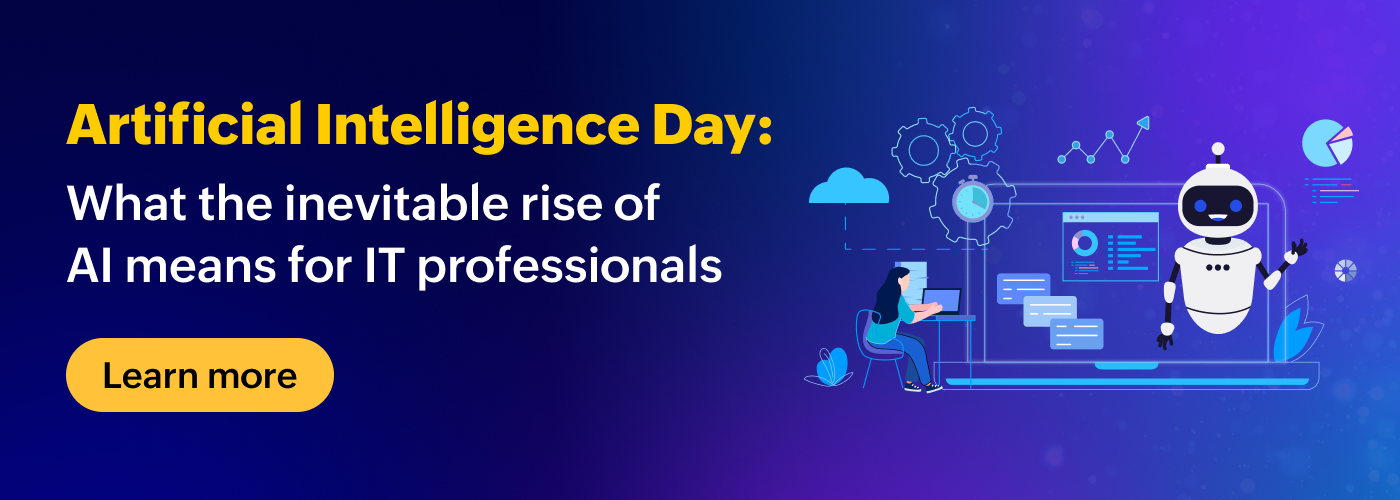In the ever-changing world of IT and digitalization, we’ve all probably pondered the same thought at least once: “Can AI ever replace me?” An example is the Tom and Jerry cartoon episode with the robot cat meant to replace Tom. Another is the video game Detroit: Become Human that navigates a world where self-aware androids surpass humans in intelligence. Fiction aside, we’re already seeing AI’s true capabilities with tools like Chat GPT and Bard. So what about IT professionals? Will AI replace them? In the spirit of Artificial Intelligence Day, let’s discuss this very question.
Meet Chris, an IT administrator
Relax. Chris isn’t another AI-powered chat bot or assistant. He’s your average IT admin in a mid-sized organization. A lot of Chris’s responsibilities include mundane, repetitive tasks usually associated with IT operations, such as running maintenance on the company’s devices, upgrading and installing new hardware and software, and troubleshooting issues when something inevitably goes wrong. Usually he can handle his job fine, but the repeated manual tasks can easily be automated, freeing up more of his time for more important tasks.
Let’s say there’s a catastrophic incident one day that leads to severe downtime. Chris now has to comb through mountains of data and tons of devices in the infrastructure to figure out what went wrong. If that isn’t enough to make Chris pull his hair out in frustration, he also has to determine the exact issue so it doesn’t happen again.
Enter AIOps
So what can help make Chris’s job easier? You probably already guessed it, given the title of the blog, but yes, AI or more specifically, artificial intelligence for IT operations (AIOps) is the answer.
AIOps uses AI and ML algorithms as well as big data to provide actionable insights. An AIOps tool can easily identify anomalies or discrepancies in your organization’s infrastructure data.These patterns are almost impossible for an IT admin to detect manually by scouring through tons of data.
AIOps tools also employ root cause analysis to determine why a problem happened. We’ve heard the saying “prevention is better than cure.” Turns out, this doesn’t just apply to getting your annual flu shot. AIOps tools use features like root cause analysis predictive analytics to streamline IT operations and help IT admins adopt a proactive approach to preventing a future crisis
AIOps and administrators: A team effort
We’ve established that AIOps plays a part in making Chris’s job easier. But should he be worried about it? Is AIOps the new robot cat that can do Tom’s job better than him?
The answer is no, or at least not yet. Currently, AIOps is only capable of automating repetitive and time-consuming tasks required in ITOM, but cannot replace the entire role of an IT admin
Even when it comes to the downtime prevention aspect of AIOps, these tools only make predictions and provide recommended fixes based on the data it’s fed. Fully automated troubleshooting is still a potential future capability for AIOps. IT admins will still need to perform the necessary preventive actions based on the insights provided by an AIOps tool. People like Chris will always need to be available to play the puppet-master, pulling the necessary strings required to seamlessly integrate AIOps with an organization’s daily workflows.
While the advancements in AIOps have undoubtedly made Chris’s job a lot easier, he doesn’t need to worry about it replacing him. The key lies in recognizing the collaborative potential between AIOps and IT administrators. Together, they make an unstoppable team, working together to save their organization from catastrophic incidents.
To learn more about AIOps, check out some our resources like our podcast and whitepaper. Thanks for reading and enjoy a happy AI Day!
